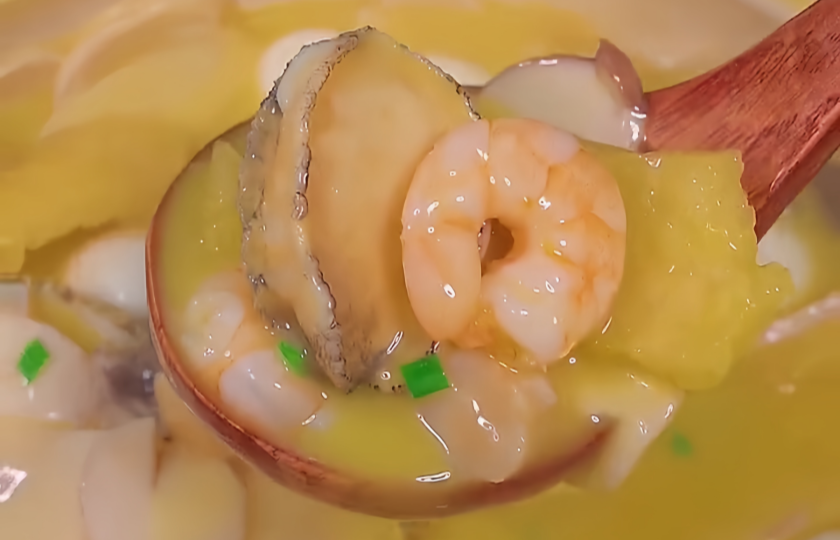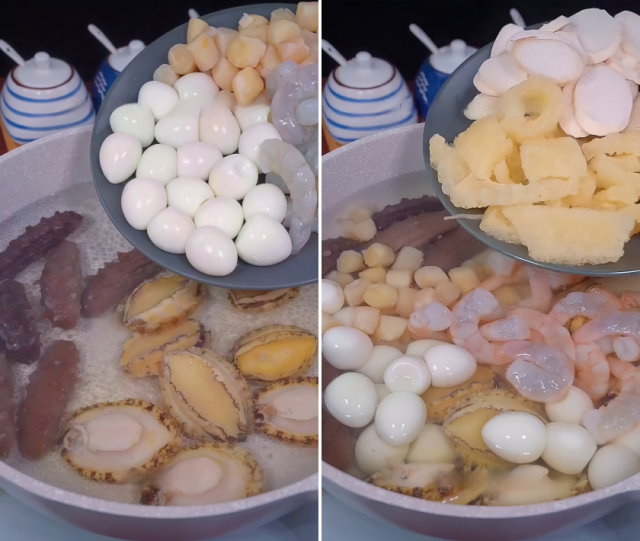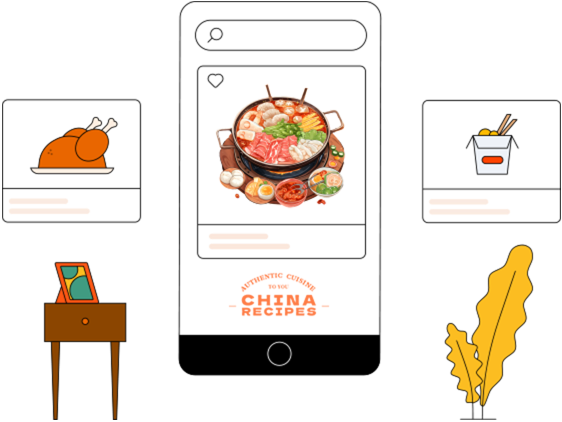Simple Buddha Jumps Over the Wall

A truly authentic Buddha Jumps Over the Wall requires the careful selection of dozens of precious ingredients and elaborate cooking to create this peerless delicacy that even the Buddha can't resist jumping over the wall for.
What is the origin of Buddha Jumps Over the Wall?
There is an interesting legend behind the name of Buddha Jumps Over the Wall. It is said that a monk smelled the aroma of this dish and couldn't help but sneak out and even jump over the wall of the temple. That's why people call it "Buddha Jumps Over the Wall".
This dish was first made by a chef in Quanzhou, Fujian during the Qing Dynasty for the nobility. Later, it gradually became a must - have dish at banquets.
What makes Buddha Jumps Over the Wall unique is that it uses a variety of precious ingredients such as sea cucumbers, abalones, scallops, etc., to simmer an extremely rich soup base. It tastes delicious with a rich texture, and can be regarded as one of the representatives of traditional "seafood feasts".

Instructions for Ingredients of Buddha Jumps Over the Wall
Sea Cucumber
If you choose dried sea cucumbers, they need to be soaked in cold water 5 days in advance. Change the water every day and store them in the refrigerator. Before cooking, blanch them with ginger slices and rice wine to remove fishiness. Their colloid can increase the thickness of the soup. If your budget is limited, you can use soaked pig tendon as a substitute.
Abalone
For fresh abalones, brush off the black film on the edge, then cook them in cold water with cooking wine until they are set. Take out the meat and keep the shells for plating to enhance the visual effect. If there are no fresh abalones, you can make cross cuts on the surface of thick - cut Pleurotus eryngii to imitate the appearance of abalones.
Scallop
Soak scallops in yellow rice wine for 2 hours, then steam them for 20 minutes until they are loose. Keep the steaming juice to season the soup. In an emergency, you can use dried small fish with oyster sauce as a substitute.
Shrimp
It is recommended to choose tiger shrimps. Make a cut on the back and remove the vein. Rub them with salt and coat with a thin layer of starch to seal the moisture. If you want a more visual impact, you can replace them with shell - on big shrimps and keep the heads to make soup.
Quail Egg
Boil quail eggs in boiling water for 4 minutes, then rinse them with cold water for easy peeling. Deep - fry them until they turn golden like tiger skin to enhance their juice - absorbing effect. Traditional pigeon eggs are more expensive, and you can replace them with halved eggs.
Pleurotus eryngii
Tear Pleurotus eryngii into thin strips along the fiber direction, blanch them and squeeze out the water. Fry them until they have charred edges. They can withstand long cooking times and look like shark fins. You can also replace them with Coprinus comatus, but you need to shorten the cooking time.
Stewed Bamboo Shoots
Fresh bamboo shoots need to be cooked in washed rice water for 15 minutes to remove the astringency. Dried bamboo shoots should be soaked in advance for 24 hours. When replacing them with water bamboo, pay attention to adjusting the order of adding them to the pot to prevent them from getting overcooked.
Pig Skin
Blanch the pig skin, scrape off the fat layer, and rub it with white vinegar to remove fishiness. Deep - fry it into crispy pig skin, and soak it until it becomes fluffy. When replacing fish maw, you need to increase the amount of pig skin to 150g.
Golden Soup Seasoning Package for Chicken with Chinese Prickly Ash
The salt content in this seasoning package is relatively high. Taste it before adding more salt later. You can make it yourself by mixing chicken broth with pumpkin puree to adjust the color, and adding Chinese prickly ash and white pepper powder to replicate the flavor.
Cornstarch Slurry
Mix cornstarch and water in a 1:2 ratio. Slowly stir it clockwise into the soup after turning off the heat until the soup becomes glaze - like. When replacing it with mashed Chinese yam, you need to cook it until it melts and strain it in advance.
Is this dish complicated?
My recipe is a simplified version. It's much easier to make than traditional Buddha Jumps Over the Wall. But if you make it in the traditional way, it's really quite complicated.
The traditional way usually requires several hours of simmering. It also involves more elaborate handling of ingredients. For example, sea cucumbers need to be soaked for a long time, and various seafood ingredients need to be carefully prepared. Moreover, the simmering time is particularly long to ensure that the flavors of each ingredient are fully released.
My method omits many cumbersome steps. I directly use the ready - made golden soup seasoning package for chicken with Chinese prickly ash and some ingredients that can be quickly simmered, which basically reduces both the time and the technical difficulty.
This simplified version enables more people to easily make it at home. It not only retains the essence of Buddha Jumps Over the Wall but also reduces complexity and long preparation time.
INGREDIENTS
Main Ingredients
-
·6 sea cucumbers
-
·9 abalones
-
·180g dried scallops
-
·150g shrimps
-
·18 quail eggs
-
·100g Pleurotus eryngii (sliced)
-
·100g pig skin
-
·100g stewed bamboo shoots (cut into sections)
Additional Ingredients
-
·30g scallions (cut into sections)
-
·30g ginger (sliced)
-
·15ml cooking wine
Seasonings
-
·1 pack of golden soup chicken with Sichuan pepper sauce
-
·A little cornstarch slurry
Table of Contents
COOKING STEP
Step 1
After the water in the pot boils, add 6 sea cucumbers, 9 abalones, 180g dried scallops, 150g shrimps, 18 quail eggs, 100g Pleurotus eryngii and 100g pig skin, 100g stewed bamboo shoots.

Step 2
Add scallions, ginger and 15ml cooking wine. Blanch for 2 minutes, then remove and set aside.

Step 3
Take 1 pack of golden soup chicken with Sichuan pepper sauce and add 500ml of plain water.

Step 4
Once the water boils, pour in all the ingredients, cover the pot, turn to low heat and simmer for about 20 minutes.

Step 5
Add a little cornstarch slurry and continue cooking until the soup thickens.

More recipes worth trying
Chinese Herbal Chicken Soup Recipe
Precautions
Ingredient Preparation: Although the process is simplified, ingredients such as sea cucumbers and abalones still need appropriate handling. Soak the sea cucumbers soft in advance. Remove the fishy smell from the abalones and cut them to an appropriate thickness. Thaw the shrimps in advance and wash them thoroughly to avoid a fishy smell.
Stewing Time: When cooking the ingredients, controlling the heat is very important. Overcooking will affect the texture of the ingredients, especially sea cucumbers and abalones are prone to becoming overcooked and losing their tenderness. Keep the heat low during stewing to ensure that the ingredients are not overcooked and maintain their fresh flavor.
Use of Golden Soup Chicken with Sichuan Pepper Sauce: The golden soup chicken with Sichuan pepper sauce already has a rich flavor, so there is no need to add too many other seasonings. Just add salt appropriately according to your taste. Avoid over-seasoning to prevent overpowering the original flavor.
Use of Cornstarch Slurry: Use the cornstarch slurry sparingly, adding it gradually while cooking to ensure that the soup thickens gradually. If too much is added, the soup will become too viscous and lose the texture of a clear soup.
Order of Adding Ingredients: When adding ingredients, it is recommended to do so in the order of hardness. For example, add sea cucumbers, abalones, dried scallops first, because these ingredients can withstand longer cooking times and can better absorb the flavor of the soup. For ingredients like shrimps and quail eggs, it is best to add them last to avoid overcooking.
Heat Control: During the final stewing, adjust the heat properly to keep the soup surface simmering gently. Do not use high heat for cooking. This way, the soup will be clearer and the ingredients will be evenly flavored.
Consumption Suggestions
Staple Food: Buddha Jumps Over the Wall can be paired with staple foods such as rice and steamed buns. The thick soup can be poured over the rice, making the rice more delicious and increasing the satiety of a meal.
Side Dishes: Pair it with some light side dishes, such as spiral - cut radish, mustard greens in oil, ham and bean sprout tips salad, stir - fried mushroom and pea seedlings. These dishes can balance the taste and relieve greasiness, making the whole dining experience more diverse.
Temperature: It is generally recommended to consume Buddha Jumps Over the Wall when it is warm. This can better showcase the richness of the soup and the freshness of the ingredients.
Taste Rhythm: When tasting Buddha Jumps Over the Wall, first taste the freshness of the soup to feel its rich aroma. Then, taste the textures and flavors of various ingredients to experience the integration and layers of different ingredients.
How to Store Leftover Buddha Jumps Over the Wall?
If there are leftovers of Buddha Jumps Over the Wall, it is recommended to store the soup base and ingredients separately in the refrigerator. It can be stored for up to 2 days.
When reheating, it is best to use the steaming method. Put the portion to be eaten in a bowl, cover it with a plate to prevent water vapor from getting in, and steam it for 8 - 10 minutes after the water boils.
FAQs:
Each ingredient combination can enhance the freshness of the soup base. Some recipes also include Chinese black mushrooms, tendon and other ingredients to make the soup base richer.

















